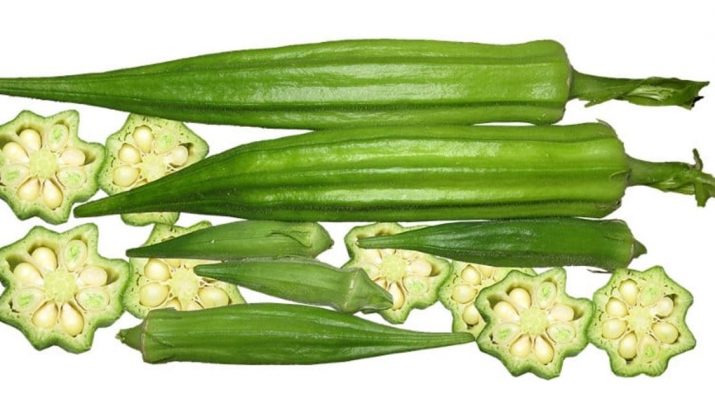Okra is an incredibly beneficial and versatile fruit that offers a plethora of health benefits and can be used in various ways in the kitchen.
Okra (Abelmoschus esculentus, or Hibiscus esculentus) is a flowering plant that belongs to the mallow family (Malvaceae) and produces large yellow flowers and a pod that measures 4-10 inches. It grows in warm climates in South America, the Middle East, and in the southern United States.
It is technically a fruit, but is eaten as a vegetable due to the rather savory taste, and is also known as lady’s fingers (or, ladies fingers), bhindi, bendakaya, bamia or gumbo. When boiled, it becomes thick, so it is often added to soups, broths, and stews. It can also be pickled, fried, or sautéed.
It is a rich source of minerals and vitamins, as well as fiber. A cup of okra provides about 40% your recommended daily vitamin C needs, which boosts the immune system, high amounts of vitamin K that boosts bone health and improves blood clotting, vitamin A, that improves vision and prevents free radical damage, as well as magnesium, potassium, calcium, iron, zinc, and folate.
Magnesium regulates blood pressure and blood sugar levels, potassium and calcium improve bone health and muscle function, and folate is essential during pregnancy, and it improves brain function and prevents anemia.
Iron ensures the health of the blood, zinc protects DNA and strengthens the immune system, while the dietary fiber improves digestion, and the multiple antioxidants eliminate free radicals.
Here are some of the numerous health benefits of okra:
- Okra prevents blood sugar spikes after meals and reduces blood glucose levels
- Okra protects the liver from damage and prevents liver disease
- Okra naturally boosts energy levels and treats fatigue
- Okra relieves stress and improves mood, and treats anxiety and depression
- Okra has potent anti-cancer properties and reduces the size of tumors, especially skin and breast cancer cells
- It reduces glucose absorption, lowers blood sugar levels, and is beneficial in the treatment of type 2 diabetes
- The high amounts of dietary fiber keep you full and help weight loss
- Okra contains no fat but is rich in compounds that lower “bad” cholesterol levels
- Okra produces a gelatinous liquid which treats gastritis, peptic ulcers, and stomach aches
- Okra boosts the cognitive abilities and prevents diseases such as Alzheimer’s disease and other degenerative neurological diseases
- Okra treats asthma symptoms and other respiratory conditions and cleanses the lungs
Okra is generally safe to consume. However, note that okra can interact with some diabetes medications, and it should be avoided in case one suffers from gastrointestinal problems, kidney stones, vein thrombosis, and blood clotting.
Always buy bright green okra pods, and avoid the ones with dark spots and cuts. You can eat the fruits fresh and slightly immature. You can keep okra in a brown paper bag in the refrigerator for no more than 2-3 days. Yet, you can also buy canned or dried okra.
Okra water is one of the healthiest drinks, and here is how to prepare it:
Wash 4 medium size okra pods, slice down their ends, poke them with a fork on opposite sides or split them in half, and place them in an 8-oz. glass of water. Leave them to soak overnight, and in the morning, squeeze the goopy substance from the pods, discard them, and drink the healthy remedy.
Here are some tips that will help you cook okra and enjoy its delicious taste:
- Always cut the okra before adding to a dish, to prevent the early formation of slime
- Soak whole okra pods in vinegar or lemon juice for half an hour before cooking. Rinse well and dry before cutting and using
- If you add okra to thicken gumbo or stews, blanch the whole, uncut okra, and then add it chopped 10 minutes before the end of cooking.
You can also try okra fritters by dipping okra slices into some beaten egg and cornmeal, pickle okra pods, or steam them sliced and add it to meat or rice and vegetables.
Here are some tasty recipes worth trying:
Pan-Fried Okra with Cornmeal
Ingredients
- 2 pounds fresh okra, stems trimmed, cut into 1/2-inch pieces
- 6 tablespoons canola oil, divided
- 2/3 cup fine yellow cornmeal
- 1 1/2 teaspoons coarse sea salt
- 1 teaspoon black pepper
- 1/8 teaspoon cayenne pepper
Instructions:
You will need two medium-size nonstick skillets, and place 1 1/2 tablespoons of the canola oil in each of them. Heat over medium-high, and divide the okra between skillets. Stir to coat, cover, and cook until okra has become bright green, for about 10 minutes.
Sprinkle okra in each skillet with 3/4 teaspoon salt and 1/2 teaspoon black pepper, stir, and divide the cayenne pepper and cornmeal evenly between the skillets.
Next, just drizzle 1 1/2 tablespoons oil over the mixture, and cook uncovered for about 6 minutes, until okra has become brown and tender.
Creole Shrimp and Okra
Ingredients
- 2 cups fresh okra, trimmed and halved lengthwise
- 3 garlic cloves, finely chopped
- 1 bay leaf
- 1 cup stone-ground polenta or grits
- 3 cups unsalted chicken stock
- 1 cup 2% reduced-fat milk
- 1/2 teaspoon kosher salt, divided
- 1 1/2 tablespoons olive oil
- 1 cup vertically sliced onion
- 3/4 cup diagonally sliced celery
- 1 pound large shrimp, peeled and deveined
- 1 1/2 tablespoons red wine vinegar
- 2 green onions, thinly sliced
- 1/2 teaspoon ground red pepper
- 1/2 teaspoon freshly ground black pepper
- 3 cups fresh marinara sauce
- 1/2 cup water
Instructions:
In a large saucepan, cook the garlic, milk, stock, and bay leaf until boiled, and then add polenta and 1/4 teaspoon salt. Stir constantly, reduce the heat to medium-low, and cook for 20 more minutes. Discard the bay leaf, and cover.
Heat a large skillet over high heat, add the oil, onions, okra, and celery, and cook them for 2-4 minutes.
Then, add the shrimp, red pepper, black pepper, and the remaining 1/4 teaspoon salt. Cook for 2 minutes, and add the sauce and 1/2 cup water. Bring to a simmer, cook 3 minutes, and add the vinegar.
In 4 bowls, add 1/2 cup polenta, top each serving with 1 1/2 cups shrimp mixture, and sprinkle evenly with green onions.
Enjoy!


